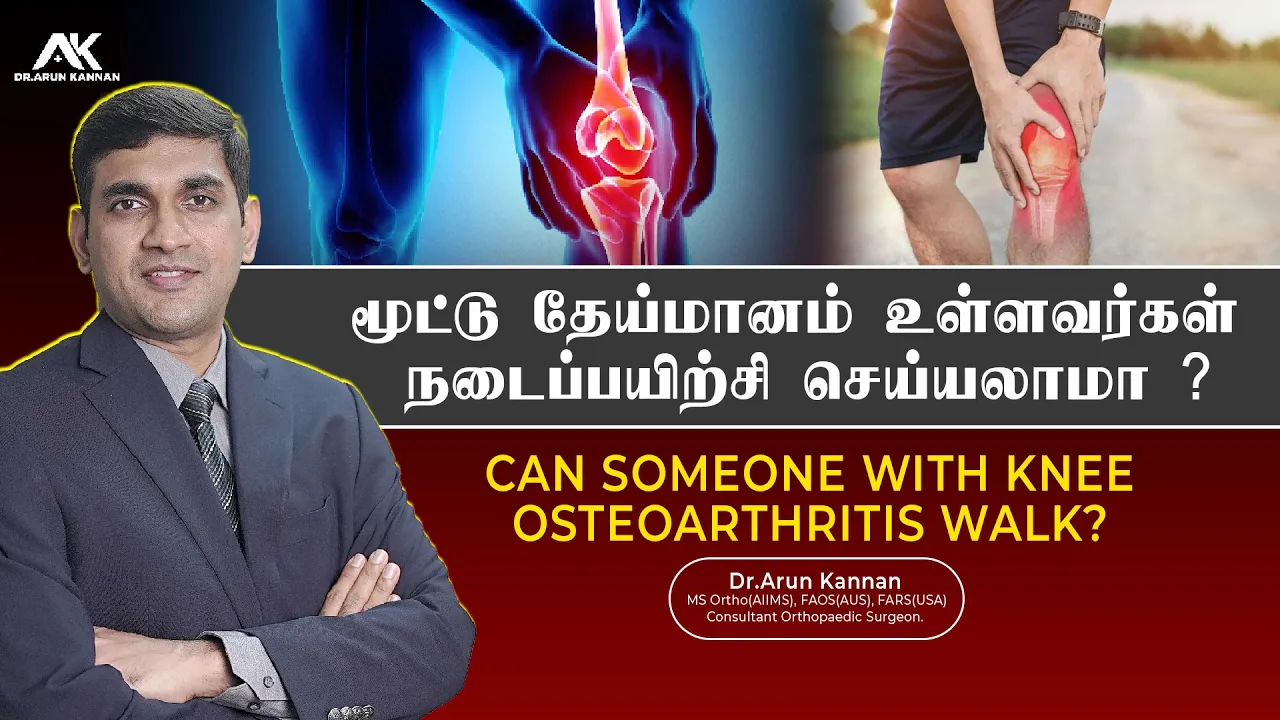 15 December, 2024
15 December, 2024
Walking and Knee Osteoarthritis: A Comprehensive Guide | Dr. Arun Kannan
In this blog, we explore the relationship between walking and knee osteoarthritis, addressing common concerns and misconceptions. Dr. Arun Kannan, an orthopedic expert, provides insights into how walking can be beneficial for managing knee pain while offering practical tips for safe and effective exercise.
Introduction to Knee Osteoarthritis
Knee osteoarthritis is a degenerative joint disease characterized by the breakdown of cartilage in the knee joint. This condition often leads to pain, stiffness, and reduced mobility, making daily activities challenging. Understanding the nature of knee osteoarthritis is crucial for managing symptoms and improving quality of life.
The Importance of Walking
Walking plays a vital role in maintaining joint health, particularly for individuals with knee osteoarthritis. It is a low-impact exercise that helps keep the joints flexible and strengthens the muscles surrounding the knee. Regular walking can aid in reducing pain and enhancing overall mobility.
Benefits of Regular Walking
- Improves Cardiovascular Health: Walking enhances heart and lung function, contributing to better cardiovascular fitness.
- Weight Management: Regular walking helps in burning calories, which can aid in weight control and reduce stress on the knees.
- Strengthens Muscles: It serves as a weight-bearing exercise, helping to maintain bone density and muscle strength.
- Enhances Mood: Physical activity, including walking, releases endorphins that can improve mood and reduce feelings of depression and anxiety.
Understanding Knee Joint Anatomy
The knee joint consists of bones, cartilage, ligaments, and tendons. Cartilage acts as a cushion between the bones, allowing smooth movement. In knee osteoarthritis, this cartilage deteriorates, leading to increased friction and pain during movement.
Components of the Knee Joint
- Femur: The thigh bone that connects to the knee.
- Tibia: The shin bone that bears most of the body’s weight.
- Patella: The kneecap that protects the knee joint.
- Cartilage: The smooth tissue that covers the ends of the bones and enables smooth movement.
Potential Risks of Walking with Osteoarthritis
While walking is beneficial, it is essential to be mindful of potential risks. Overexertion can lead to increased pain and discomfort. Individuals should listen to their bodies and adjust their walking routines accordingly.
Signs of Overexertion
- Increased joint pain during or after walking.
- Swelling in the knee joint.
- Stiffness that lasts for an extended period post-exercise.
Activities to Avoid for Knee Health
To protect knee health, certain activities should be avoided. High-impact exercises can exacerbate knee pain and lead to further joint damage.
Activities to Avoid
- Squatting: This puts excessive strain on the knees.
- Stair Climbing: Ascending and descending stairs can increase joint stress.
- Running: High-impact running can worsen knee osteoarthritis symptoms.
Recommended Walking Duration
For individuals with knee osteoarthritis, a general guideline is to walk for at least 20 minutes a day. This duration can help maintain cardiovascular fitness without overwhelming the joints.
Walking Recommendations
- Start with 10-15 minutes if new to walking.
- Gradually increase to 20-30 minutes as tolerated.
- Walk at a comfortable pace to avoid strain.
Adjusting Walking Intensity Based on Pain
When managing knee osteoarthritis, adjusting walking intensity based on pain levels is crucial. Individuals should monitor their pain during and after walking sessions. If pain increases, it is advisable to reduce the duration or intensity of the walk.
Listening to your body is key. If you experience pain that lasts beyond a few hours after walking, consider shortening your walks or taking more frequent breaks. The goal is to find a balance that allows for movement without exacerbating pain.
Guidelines for Adjusting Intensity
- Start Slow: Begin with shorter durations, such as 10-15 minutes, and gradually increase as tolerated.
- Use Pain as a Guide: If you feel pain during walking, slow down or take a break.
- Limit Walking Time: Aim for 20-30 minutes of walking, but adjust based on your comfort level.
- Incorporate Rest Days: Allow time for recovery, especially if experiencing increased pain.
Alternative Exercises for Knee Osteoarthritis
While walking is beneficial, alternative exercises can provide variety and reduce strain on the knees. Incorporating low-impact activities can help maintain fitness levels while minimizing discomfort.
Recommended Alternative Exercises
- Cycling: Cycling is an excellent low-impact exercise that strengthens the legs without putting excessive pressure on the knees.
- Swimming: Swimming engages multiple muscle groups and provides a full-body workout while minimizing joint stress.
- Aquatic Aerobics: Exercising in water reduces the weight on joints, making it easier to perform movements.
- Yoga: Gentle stretches and poses can improve flexibility and strengthen muscles around the knees.
Proper Walking Techniques
Adopting proper walking techniques can enhance the benefits of walking while minimizing the risk of injury. Focus on form and posture to ensure a safe walking experience.
Key Walking Techniques
- Maintain Good Posture: Keep your head up, shoulders relaxed, and back straight to promote proper alignment.
- Use a Comfortable Stride: Avoid overstriding. Take shorter, more controlled steps to reduce impact.
- Engage Your Core: A strong core provides stability and support during walking.
- Land Softly: Focus on landing softly on your heels and rolling through to your toes, which helps absorb shock.
The Role of Footwear in Walking
Footwear plays a significant role in walking comfort and knee health. Choosing the right shoes can help reduce pain and improve overall walking experience.
Choosing the Right Footwear
- Supportive Shoes: Look for shoes with good arch support and cushioning to absorb impact.
- Avoid High Heels: High-heeled shoes can alter your gait and increase stress on the knees.
- Consider Orthotics: Custom orthotics can provide additional support and alleviate pressure on the knees.
- Replace Worn-Out Shoes: Regularly check the condition of your shoes and replace them when they show signs of wear.
Conclusion and Final Thoughts
Walking is a vital component in managing knee osteoarthritis, offering numerous health benefits while promoting mobility. It is essential to listen to your body and adjust walking intensity based on pain levels. Incorporating alternative exercises and proper walking techniques can further enhance your experience.
Remember, the right footwear is crucial for comfort and support. By taking these steps, individuals with knee osteoarthritis can lead active, fulfilling lives while effectively managing their condition. Consistency and mindfulness in your approach will yield the best results.
FAQ: Common Questions About Walking and Osteoarthritis
1. How often should I walk if I have knee osteoarthritis?
Aim for at least 20-30 minutes of walking most days of the week, adjusting as needed based on your comfort level.
2. Is walking safe for everyone with knee osteoarthritis?
While walking is generally safe, individuals should consult their healthcare provider to tailor an exercise plan based on their specific condition.
3. What should I do if my knee pain worsens after walking?
If knee pain worsens, reduce the duration or intensity of your walks, and consider alternative exercises that are less stressful on the joints.
4. Can I walk if I have severe knee osteoarthritis?
Walking may still be beneficial, but it is crucial to proceed with caution. Consult a healthcare professional for personalized recommendations.
5. Are there specific walking techniques I should follow?
Focus on maintaining good posture, using a comfortable stride, engaging your core, and landing softly to minimize impact on the knees.

